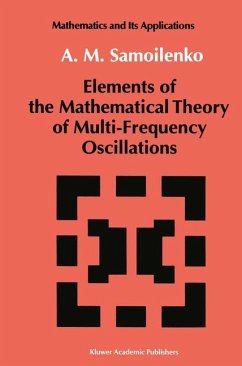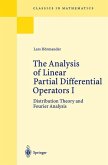A.M Samoilenko
Elements of the Mathematical Theory of Multi-Frequency Oscillations
A.M Samoilenko
Elements of the Mathematical Theory of Multi-Frequency Oscillations
- Gebundenes Buch
- Merkliste
- Auf die Merkliste
- Bewerten Bewerten
- Teilen
- Produkt teilen
- Produkterinnerung
- Produkterinnerung
Translated from the original Russian edition of 1987 (Nauka, Moscow), this volume deals with the theory of multi-frequency oscillations as a motion of a dynamical system which describes a recurrent trajectory on an invariant toroidal manifold of the system. In this way, the invariant toroidal manifo
Andere Kunden interessierten sich auch für
![Elements of the Mathematical Theory of Multi-Frequency Oscillations Elements of the Mathematical Theory of Multi-Frequency Oscillations]() Anatolii M. SamoilenkoElements of the Mathematical Theory of Multi-Frequency Oscillations39,99 €
Anatolii M. SamoilenkoElements of the Mathematical Theory of Multi-Frequency Oscillations39,99 €![The Analysis of Linear Partial Differential Operators I The Analysis of Linear Partial Differential Operators I]() Lars HörmanderThe Analysis of Linear Partial Differential Operators I43,99 €
Lars HörmanderThe Analysis of Linear Partial Differential Operators I43,99 €![Foundations of the Classical Theory of Partial Differential Equations Foundations of the Classical Theory of Partial Differential Equations]() Yu.V. EgorovFoundations of the Classical Theory of Partial Differential Equations39,99 €
Yu.V. EgorovFoundations of the Classical Theory of Partial Differential Equations39,99 €![Singularity Theory I Singularity Theory I]() V.I. ArnoldSingularity Theory I58,99 €
V.I. ArnoldSingularity Theory I58,99 €![Univalent Functions and Teichmüller Spaces Univalent Functions and Teichmüller Spaces]() O. LehtoUnivalent Functions and Teichmüller Spaces56,99 €
O. LehtoUnivalent Functions and Teichmüller Spaces56,99 €![Asymptotic Analysis II Asymptotic Analysis II]() Asymptotic Analysis II35,99 €
Asymptotic Analysis II35,99 €![Inner Product Structures Inner Product Structures]() V. I. IstratescuInner Product Structures84,99 €
V. I. IstratescuInner Product Structures84,99 €-
-
-
Translated from the original Russian edition of 1987 (Nauka, Moscow), this volume deals with the theory of multi-frequency oscillations as a motion of a dynamical system which describes a recurrent trajectory on an invariant toroidal manifold of the system. In this way, the invariant toroidal manifo
Produktdetails
- Produktdetails
- Mathematics and Its Applications 71
- Verlag: Springer / Springer Netherlands
- Artikelnr. des Verlages: 978-0-7923-1438-7
- 1991.
- Seitenzahl: 336
- Erscheinungstermin: 31. Oktober 1991
- Englisch
- Abmessung: 241mm x 160mm x 23mm
- Gewicht: 649g
- ISBN-13: 9780792314387
- ISBN-10: 0792314387
- Artikelnr.: 21709463
- Herstellerkennzeichnung
- Springer-Verlag GmbH
- Tiergartenstr. 17
- 69121 Heidelberg
- ProductSafety@springernature.com
- Mathematics and Its Applications 71
- Verlag: Springer / Springer Netherlands
- Artikelnr. des Verlages: 978-0-7923-1438-7
- 1991.
- Seitenzahl: 336
- Erscheinungstermin: 31. Oktober 1991
- Englisch
- Abmessung: 241mm x 160mm x 23mm
- Gewicht: 649g
- ISBN-13: 9780792314387
- ISBN-10: 0792314387
- Artikelnr.: 21709463
- Herstellerkennzeichnung
- Springer-Verlag GmbH
- Tiergartenstr. 17
- 69121 Heidelberg
- ProductSafety@springernature.com
1. Periodic and quasi-periodic functions.- 1.1. The function spaces $$C^r left( {mathcal{T}_m } right)$$and $$H^r left( {mathcal{T}_m } right)$$.- 1.2. Structure of the spaces $$H^r left( {mathcal{T}_m } right)$$. Sobolev theorems.- 1.3. Main inequalities in $$C^r left( omega right)$$.- 1.4. Quasi-periodic functions. The spaces $$H^r left( omega right)$$.- 1.5. The spaces $$H^r left( omega right)$$ and their structure.- 1.6. First integral of a quasi-periodic function.- 1.7. Spherical coordinates of a quasi-periodic vector function.- 1.8. The problem on a periodic basis in En.- 1.9. Logarithm of a matrix in $$C^l left( {mathcal{T}_m } right)$$. Sibuja's theorem.- 1.10. Gårding's inequality.- 2. Invariant sets and their stability.- 2.1. Preliminary notions and results.- 2.2. One-sided invariant sets and their properties.- 2.3. Locally invariant sets. Reduction principle.- 2.4. Behaviour of an invariant set under small perturbations of the system.- 2.5. Quasi-periodic motions and their closure.- 2.6. Invariance equations of a smooth manifold and the trajectory flow on it.- 2.7. Local coordinates in a neighbourhood of a toroidal manifold. Stability of an invariant torus.- 2.8. Recurrent motions and multi-frequency oscillations.- 3. Some problems of the linear theory.- 3.1. Introductory remarks and definitions.- 3.2. Adjoint system of equations. Necessary conditions for the existence of an invariant torus.- 3.3. Necessary conditions for the existence of an invariant torus of a linear system with arbitrary non-homogeneity in $$Cleft( {mathcal{T}_m } right)$$.- 3.4. The Green's function. Sufficient conditions for the existence of an invariant torus.- 3.5. Conditions for the existence of an exponentially stable invariant torus.-3.6. Uniqueness conditions for the Green's function and the properties of this function.- 3.7. Separatrix manifolds. Decomposition of a linear system.- 3.8. Sufficient conditions for exponential dichotomy of an invariant torus.- 3.9. Necessary conditions for an invariant torus to be exponentially dichotomous.- 3.10. Conditions for the $$C'left( {mathcal{T}_m } right)$$-block decomposability of an exponentially dichotomous system.- 3.11. On triangulation and the relation between the $$C'left( {mathcal{T}_m } right)$$)-block decomposability of a linear system and the problem of the extendability of an r-frame to a periodic basis in En.- 3.12. On smoothness of an exponentially stable invariant torus.- 3.13. Smoothness properties of Green's functions, the invariant torus and the decomposing transformation of an exponentially dichotomous system.- 3.14. Galerkin's method for the construction of an invariant torus.- 3.15. Proof of the main inequalities for the substantiation of Galerkin's method.- 4. Perturbation theory of an invariant torus of a non¬linear system.- 4.1. Introductory remarks. The linearization process.- 4.2. Main theorem.- 4.3. Exponential stability of an invariant torus and conditions for its preservation under small perturbations of the system.- 4.4. Theorem on exponential attraction of motions in a neighbourhood of an invariant torus of a system to its motions on the torus.- 4.5. Exponential dichotomy of invariant torus and conditions for its preservation under small perturbations of the system.- 4.6. An estimate of the smallness of a perturbation and the maximal smoothness of an invariant torus of a non-linear system.- 4.7. Galerkin's method for the construction of an invariant torus of a non-linear system of equations and its linearmodification.- 4.8. Proof of Moser's lemma.- 4.9. Invariant tori of systems of differential equations with rapidly and slowly changing variables.- Author index.- Index of notation.
1. Periodic and quasi-periodic functions.- 1.1. The function spaces $$C^r left( {mathcal{T}_m } right)$$and $$H^r left( {mathcal{T}_m } right)$$.- 1.2. Structure of the spaces $$H^r left( {mathcal{T}_m } right)$$. Sobolev theorems.- 1.3. Main inequalities in $$C^r left( omega right)$$.- 1.4. Quasi-periodic functions. The spaces $$H^r left( omega right)$$.- 1.5. The spaces $$H^r left( omega right)$$ and their structure.- 1.6. First integral of a quasi-periodic function.- 1.7. Spherical coordinates of a quasi-periodic vector function.- 1.8. The problem on a periodic basis in En.- 1.9. Logarithm of a matrix in $$C^l left( {mathcal{T}_m } right)$$. Sibuja's theorem.- 1.10. Gårding's inequality.- 2. Invariant sets and their stability.- 2.1. Preliminary notions and results.- 2.2. One-sided invariant sets and their properties.- 2.3. Locally invariant sets. Reduction principle.- 2.4. Behaviour of an invariant set under small perturbations of the system.- 2.5. Quasi-periodic motions and their closure.- 2.6. Invariance equations of a smooth manifold and the trajectory flow on it.- 2.7. Local coordinates in a neighbourhood of a toroidal manifold. Stability of an invariant torus.- 2.8. Recurrent motions and multi-frequency oscillations.- 3. Some problems of the linear theory.- 3.1. Introductory remarks and definitions.- 3.2. Adjoint system of equations. Necessary conditions for the existence of an invariant torus.- 3.3. Necessary conditions for the existence of an invariant torus of a linear system with arbitrary non-homogeneity in $$Cleft( {mathcal{T}_m } right)$$.- 3.4. The Green's function. Sufficient conditions for the existence of an invariant torus.- 3.5. Conditions for the existence of an exponentially stable invariant torus.-3.6. Uniqueness conditions for the Green's function and the properties of this function.- 3.7. Separatrix manifolds. Decomposition of a linear system.- 3.8. Sufficient conditions for exponential dichotomy of an invariant torus.- 3.9. Necessary conditions for an invariant torus to be exponentially dichotomous.- 3.10. Conditions for the $$C'left( {mathcal{T}_m } right)$$-block decomposability of an exponentially dichotomous system.- 3.11. On triangulation and the relation between the $$C'left( {mathcal{T}_m } right)$$)-block decomposability of a linear system and the problem of the extendability of an r-frame to a periodic basis in En.- 3.12. On smoothness of an exponentially stable invariant torus.- 3.13. Smoothness properties of Green's functions, the invariant torus and the decomposing transformation of an exponentially dichotomous system.- 3.14. Galerkin's method for the construction of an invariant torus.- 3.15. Proof of the main inequalities for the substantiation of Galerkin's method.- 4. Perturbation theory of an invariant torus of a non¬linear system.- 4.1. Introductory remarks. The linearization process.- 4.2. Main theorem.- 4.3. Exponential stability of an invariant torus and conditions for its preservation under small perturbations of the system.- 4.4. Theorem on exponential attraction of motions in a neighbourhood of an invariant torus of a system to its motions on the torus.- 4.5. Exponential dichotomy of invariant torus and conditions for its preservation under small perturbations of the system.- 4.6. An estimate of the smallness of a perturbation and the maximal smoothness of an invariant torus of a non-linear system.- 4.7. Galerkin's method for the construction of an invariant torus of a non-linear system of equations and its linearmodification.- 4.8. Proof of Moser's lemma.- 4.9. Invariant tori of systems of differential equations with rapidly and slowly changing variables.- Author index.- Index of notation.









